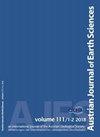Old orogen – young topography: Evidence for relief rejuvenation in the Bohemian Massif
IF 1.1
4区 地球科学
Q2 Earth and Planetary Sciences
引用次数: 0
Abstract
Abstract The Bohemian Massif is the relic of a major Paleozoic mountain range that is known to have exhumed and its surface levelled in the Permian, but its Neogene landscape evolution is largely unconstrained. The landscape is characterized by rolling hills and extended planation surfaces above an elevation of about 500 m. However, at lower elevations deeply incised gorges confined by steep hillslopes are abundant and contrast impressively with the low relief landscapes above. Rivers with a bimodal morphology (i.e. steep at lower elevations and gentle at higher elevations) drain either to the north into the Vltava (Moldau) River or to the south into the Danube River. Hence, a continental drainage divide runs through the Bohemian Massif. Here, we quantify spatial characteristics of the Bohemian Massif landforms by computing landscape metrics like steepness index or geophysical relief derived from digital elevation models. From this we infer temporal change of the landscape in the past and predict them for the future evolution of the region. We show that the landscape is characterized by out-of-equilibrium river profiles with knickpoints abundantly at elevations between 450 m and 550 m separating steep channel segments at lower elevations from less steep channels at higher elevations. Hypsometric maxima at or close above knickpoint elevations, along with high and low values in geophysical relief as indicator for the degree of fluvial landscape dissection downstream and upstream of major knickpoints, support the idea of landscape bimodality. Furthermore, we find a distinct drainage divide asymmetry, which causes the reorganization of the drainage network of the region. Across-divide gradients in channel steepness predict the northward migration of the Danube-Vltava drainage divide including growth and shrinkage of tributary catchments, thus controlling changes in the Central European drainage pattern. All aspects suggest that the region experienced relief rejuvenation during the last few million years. We suggest that this relief rejuvenation is related to the inversion of the Molasse basin with a long wavelength rock uplift pattern and low uplift rates. Vertical motion of crustal blocks at discrete faults may locally affect the uplift pattern. However, the contrasting bedrock properties between the sedimentary cover (Molasse sediments) and the crystalline basement (Bohemian Massif) cause substantial differences in erosion rate and are thus the superior control on the topographic variations of the entire region.老造山带-年轻地形:波西米亚地块地形恢复的证据
摘要波西米亚地块是一个主要古生代山脉的遗迹,已知该山脉在二叠纪被挖掘出来,其表面被整平,但其上第三纪的景观演变在很大程度上是不受约束的。该景观的特点是起伏的山丘和海拔约500米以上的延伸夷平面。然而,在较低的海拔地区,由陡峭山坡限制的深切峡谷非常丰富,与上面的低起伏景观形成了鲜明对比。具有双峰形态的河流(即低海拔地区陡峭,高海拔地区平缓)向北流入伏尔塔瓦河或向南流入多瑙河。因此,一条大陆排水分水岭贯穿波西米亚地块。在这里,我们通过计算从数字高程模型导出的陡度指数或地球物理起伏等景观指标来量化波西米亚地块地貌的空间特征。据此,我们推断出过去景观的时间变化,并预测该地区未来的演变。我们发现,该景观的特点是河流剖面失衡,在海拔450米至550米之间有大量的拐点,将低海拔的陡峭河道段与高海拔的不太陡峭的河道分隔开来。在拐点高程处或接近拐点高程处的测高最大值,以及作为主要拐点下游和上游河流景观剥离程度指标的地球物理起伏的高值和低值,支持景观双峰性的观点。此外,我们发现了明显的流域划分不对称性,这导致了该地区流域网络的重组。河道陡度的跨分水岭梯度预测了多瑙河-伏尔塔瓦流域分水岭的向北迁移,包括支流集水区的增长和萎缩,从而控制了中欧流域格局的变化。所有方面都表明,该地区在过去几百万年中经历了救济复兴。我们认为,这种地貌恢复与Molasse盆地的反转有关,该盆地具有长波长的岩石抬升模式和低抬升速率。离散断层处地壳块体的垂直运动可能局部影响隆起模式。然而,沉积覆盖层(Molasse沉积物)和结晶基底(Bohemian Massif)之间对比鲜明的基岩特性导致侵蚀速率的显著差异,因此对整个区域的地形变化具有较好的控制作用。
本文章由计算机程序翻译,如有差异,请以英文原文为准。
求助全文
约1分钟内获得全文
求助全文
来源期刊

Austrian Journal of Earth Sciences
Earth and Planetary Sciences-Paleontology
CiteScore
3.10
自引率
0.00%
发文量
0
审稿时长
>12 weeks
期刊介绍:
AUSTRIAN JOURNAL OF EARTH SCIENCES is the official journal of the Austrian Geological, Mineralogical and Palaeontological Societies, hosted by a country that is famous for its spectacular mountains that are the birthplace for many geological and mineralogical concepts in modern Earth science.
AUSTRIAN JOURNAL OF EARTH SCIENCE focuses on all aspects relevant to the geosciences of the Alps, Bohemian Massif and surrounding areas. Contributions on other regions are welcome if they embed their findings into a conceptual framework that relates the contribution to Alpine-type orogens and Alpine regions in general, and are thus relevant to an international audience. Contributions are subject to peer review and editorial control according to SCI guidelines to ensure that the required standard of scientific excellence is maintained.
 求助内容:
求助内容: 应助结果提醒方式:
应助结果提醒方式:


